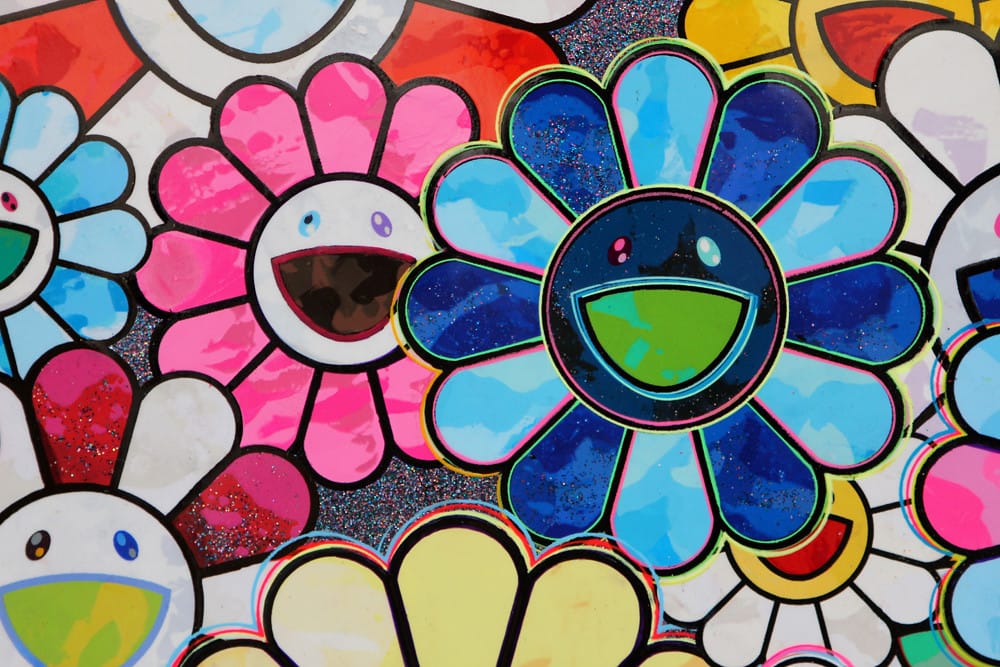Takashi Murakami is a globally recognized artist in the realm of art. His brightly colored, happy flowers not only nicely capture his style of painting, but they have also had a significant influence on contemporary sculpture overall.
The Role of Flowers
It is possible to recognize the Takashi Murakami flowers by their vibrant colors, simple shapes, and cheerful attitudes. These flowers appear in merchandise, paintings, prints, sculptures, and other forms of media. They can be observed in huge bunches. They exhibit the signature ” Super flat” style of Murakami, which combines traditional Japanese art forms with a two-dimensional, flat aesthetic influenced by manga and anime.
But why are these flowers so significant in contemporary art? The “Takashi Murakami flowers” are more than just simple beautiful patterns. They are an examination of commercial art, consumer culture, and the combination of high and low art. Murakami invites the audience to reevaluate what art is capable of expressing by integrating something as basic as a flower with significant implications.
The Impact on Contemporary Sculpture
Murakami’s flower designs have an impact that goes beyond two-dimensional art. His influence on contemporary sculpture can be seen in both themes and direct adaptations. Murakami’s colorful palette, unique forms, and hidden meanings have served as inspiration for sculptors. For instance, contemporary sculpture increasingly adopts Murakami’s style by using vivid colors, simple shapes, and pop culture references.
There are modern sculptors who got inspiration from the “Takashi Murakami flowers.” Works that recreate the flower concept in three-dimensional form and turn them into large sculptures or installations show this. These works of art often explore new materials and dimensions while maintaining the cheery, colorful style of Murakami’s work.
The more broad concepts in Murakami’s work, like the mix of both high and low culture and his examination of materialism, have served as inspiration for other artists.
Even though these sculptors’ works don’t specifically mention the “Takashi Murakami flowers,” they have a similar aesthetic. By analyzing the ways in which Murakami’s concepts inspire modern sculpture, we are able to identify a tendency toward art that bridges the gap between popular appeal and artistic depth by being both accessible and stimulating.
Contemporary Sculpture and Popular Culture
With artists like Takashi Murakami leading the way, the bond between popular culture and contemporary sculpture has been stronger over the years. Many contemporary sculptors have been influenced by him to accept popular culture as an acceptable source of creative inspiration. These artists therefore, challenge the traditional lines that divide what is considered “high art” and “low art.”
For instance, Murakami’s approach provided some conceptual framework for contemporary sculptures that borrow from pop culture, whether through the use of consumer goods, iconic figures, or cultural symbols. Like Murakami’s artwork, these sculptures have a vibrant whimsical style that attracts a larger audience while yet having deeper significance for those who are willing to look more closely.
The Commercialization of Contemporary Sculpture
The growing commercialization of sculpture as an art form is yet another way that Murakami has influenced contemporary sculpture. Contemporary sculpture has embraced the commercial side of art, much like his “Flowers” have become a brand unto themselves, with sales ranging from luxury goods to cozy toys. This could be seen in the way some sculptors collaborate with brands, create limited-edition pieces, or make pieces specifically for the art market.
Even though the commercialization of contemporary art might put doubt on its authenticity, it also brings attention to the ways in which the art industry is developing. Murakami’s approach has democratized art in many ways, bringing it out to a larger audience.
Similar to this, contemporary sculptors who accept commercial elements are coming up with innovative ways to interact with audiences, whether it through large-scale public installations or mass-produced pieces.
The Future of Contemporary Sculpture
It is very possible that artists such as Takashi Murakami will continue to make an impact on contemporary sculpture. It’s likely that future generations of artists might be influenced by his “Flowers” and will use the pattern in other creative ways. As contemporary sculptors explore with new ideas and materials, the general themes discovered in Murakami’s work—such as the intersection of high and low culture, the commercialization of art, and the embracing the popular culture—will maintain their importance.
In conclusion, the “Takashi Murakami flowers” symbolize a change in how we experience and communicate with contemporary art, going beyond just being a visual symbol. Not only have they directly adapted the flower motif, but their impact may also be seen in the more general trends that have emerged in contemporary sculpture. Murakami’s legacy will certainly continue to be an essential point of reference for contemporary sculpture as it pushes boundaries farther and encourages artists to look into the dynamic interaction between art, culture, and commerce.
Keep an eye for more news & updates on Discover Tribune!


